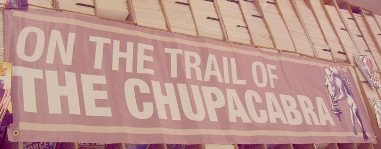
September 7, 2006
Let us celebrate the 11th anniversary of the first cryptid of the Internet Age: Chupacabras.

In August and September 1995, the chupacabras (Spanish for "goatsucker" – the singular and plural forms) seemed to erupt on the cryptozoological landscape. I’m not talking about the mangy dogs that have been mistaken for Chupacabras in recent years. No, I mean the sightings – as if out-of-the-blue – of large, upright, goat-sucking, spiked creatures that were seen in Puerto Rico in increasing numbers a mere eleven years ago.
Researchers such as Scott Corrales and Jorge Martin have since backtracked the critters through Indian lore to the 1970s and then further into the past. The year 1995, however, will be remembered as the official year of the "Chupacabras Explosion."
At first heavily discussed in local Latin American media, Chupacabras quickly became a major topic of chatter on the Internet, via emails and chatrooms. Before the end of the year, college campuses across the Americas experienced the first major use of websites to promote a new cryptozoological phenomenon: Chupacabras. Then in March 1996 a segment on Chupacabras appeared on the TV talk show "Christina," the Spanish-language Univision network’s popular counterpart to Oprah Winfrey. The show drew a tremendous response, and Chupacabras updates became a regular feature of the program, on the Internet, and around college campus chatrooms. Soon after, ABC News quoted me as saying (it now has become a classic line about the events): "What’s unique about the Chupacabras is it is crossing languages, which I think shows how small our world is becoming. It’s sort of like Jennifer Lopez, kind of cross-cultural."
While a few who seem to practice cryptoxenophobia caused the initial exclusion of Chupacabras from cryptozoology, forgetting perhaps that most creatures are fantastic and culturally-framed in the beginning of their introduction to cryptozoology, today almost everyone understands that Chupacabras are here to stay, firmly, as cryptids to be dealt with from year to year.
The legend of this livestock-slaughtering monster was born in small villages in Puerto Rico in 1995 and quickly spread to Mexico and Hispanic communities in the United States on its way to becoming a worldwide sensation like no unexplained creature since Bigfoot issued from the events of 1958 and 1967.
Chupacabras became important quickly. I deemed them so culturally significant by 1999 that I recognized them as one of the subjects in the world’s first handbook on cryptozoology and placed them in the text and honored them in the subtitle of my and Jerome Clark’s Cryptozoology A to Z: The Encyclopedia of Loch Monsters, Sasquatch, Chupacabras, and Other Authentic Mysteries of Nature, from Simon & Schuster.

On this 11th anniversary, I share one of the first cases, which occurred at the beginning of the cultural awareness of their appearances – even before some people were labeling them chupacabras:
September 7, 1995 – On this evening in Campo Rico, Canovanas, Puerto Rico a five-foot tall humanoid creature attacked a police officer’s chow chow dog. The officer fired his pistol at the creature, which doubled into a ball, bounced against a wall, and ran away at a high speed. A mutilated goat was found in the area the next day. On the same night Misael Negron observed a strange creature standing on his second story balcony for about ten minutes. He described the creature as about five feet tall, with dark skin, a round head and pointy chin, large red eyes, no ears and what appeared to be two long fangs coming out of its mouth. It had a thin neck and thin arms with three fingered hands that had sharp claws.
Source of this case: Albert Rosales, Humanoid Contact Database, cases 2299 & 2300, citing Jorge Martin, Evidencia OVNI, issue # 8.

About Loren Coleman
Loren Coleman is one of the world’s leading cryptozoologists, some say “the” leading living cryptozoologist. Certainly, he is acknowledged as the current living American researcher and writer who has most popularized cryptozoology in the late 20th and early 21st centuries.
Starting his fieldwork and investigations in 1960, after traveling and trekking extensively in pursuit of cryptozoological mysteries, Coleman began writing to share his experiences in 1969. An honorary member of Ivan T. Sanderson’s Society for the Investigation of the Unexplained in the 1970s, Coleman has been bestowed with similar honorary memberships of the North Idaho College Cryptozoology Club in 1983, and in subsequent years, that of the British Columbia Scientific Cryptozoology Club, CryptoSafari International, and other international organizations. He was also a Life Member and Benefactor of the International Society of Cryptozoology (now-defunct).
Loren Coleman’s daily blog, as a member of the Cryptomundo Team, served as an ongoing avenue of communication for the ever-growing body of cryptozoo news from 2005 through 2013. He returned as an infrequent contributor beginning Halloween week of 2015.
Coleman is the founder in 2003, and current director of the International Cryptozoology Museum in Portland, Maine.
Filed under Breaking News, Chupacabras, Cryptotourism, CryptoZoo News, Cryptozoology, Eyewitness Accounts, Folklore, Media Appearances